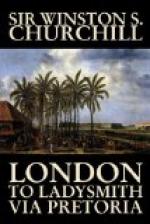But if the attack was superb, the defence was magnificent; nor could the devoted heroism of the Irish soldiers surpass the stout endurance of the Dutch. The Artillery redoubled their efforts. The whole summit of the hill was alive with shell. Shrapnel flashed into being above the crests, and the ground sprang up into dust whipped by the showers of bullets and splinters. Again and again whole sections of the entrenchments vanished in an awful uprush of black earth and smoke, smothering the fierce blaze of the lyddite shells from the howitzers and heavy artillery. The cannonade grew to tremendous thundering hum. Not less than sixty guns were firing continuously on the Boer trenches. But the musketry was never subdued for an instant. Amid the smoke and the dust the slouch hats could still be seen. The Dutch, firm and undaunted, stood to their parapets and plied their rifles with deadly effect.
The terrible power of the Mauser rifle was displayed. As the charging companies met the storm of bullets they were swept away. Officers and men fell by scores on the narrow ridge. Though assailed in front and flank by the hideous whispering Death, the survivors hurried obstinately onward, until their own artillery were forced to cease firing, and it seemed that, in spite of bullets, flesh and blood would prevail. But at the last supreme moment the weakness of the attack was shown. The Inniskillings had almost reached their goal. They were too few to effect their purpose; and when the Boers saw that the attack had withered they shot all the straighter, and several of the boldest leapt out from their trenches and, running forward to meet the soldiers, discharged their magazines at the closest range. It was a frantic scene of blood and fury.
Thus confronted, the Irish perished rather than retire. A few men indeed ran back down the slope to the nearest cover, and there savagely turned to bay, but the greater part of the front line was shot down. Other companies, some from the Connaught Rangers, some headed by the brave Colonel Sitwell, from the Dublin Fusiliers, advanced to renew—it was already too late to support—the attack, and as the light faded another fierce and bloody assault was delivered and was repulsed. Yet the Irish soldiers would not leave the hill, and, persuaded at length that they could not advance further, they lay down on the ground they had won, and began to build walls and shelters, from behind which they opened a revengeful fire on the exulting Boers. In the two attacks both colonels, three majors, twenty officers, and six hundred men had fallen out of an engaged force of scarcely one thousand two hundred. Then darkness pulled down the curtain, and the tragedy came to an end for the day.
All through the night of the 23rd a heavy rifle fire was maintained by both sides. Stray bullets whistled about the bivouacs, and the South African Light Horse, who had selected a most sheltered spot to sleep in, had a trooper hit. There were a certain number of casualties along the whole front. As soon as it was daylight I rode out with Captain Brooke to learn what had happened in the night. We knew that the hill had not been carried before dusk, but hoped, since the combatants were so close together, that in the darkness the bayonet would have settled the matter.




